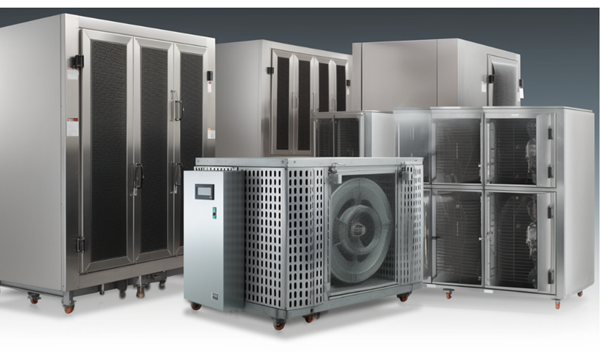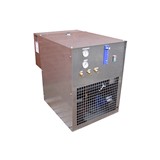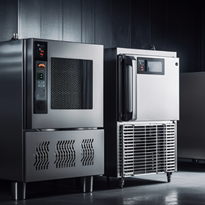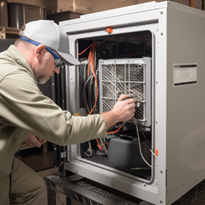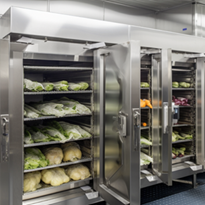Blast chiller technology continues to evolve, offering new and innovative features that enhance efficiency, convenience, and performance. In this article, we'll explore some of the latest advancements in blast chiller technology that are shaping the industry.
1. Precision Cooling and Sensor Technology
Newer blast chiller models incorporate advanced sensor technology to ensure precise and consistent cooling. These sensors continuously monitor the internal temperature of the chiller and adjust the cooling process accordingly, maintaining the desired temperature range with accuracy. This level of precision helps preserve food quality and minimize energy consumption.


Find the right Blast Chiller
Compare quotes from expert Australian suppliers and make the best choice. It's free, quick and easy!
2. Touchscreen Control Panels and Intuitive Interfaces
Modern blast chillers often feature user-friendly touchscreen control panels and intuitive interfaces. These interfaces provide easy access to various settings and functions, allowing operators to control the chilling process with simplicity and efficiency. Touchscreen panels also offer enhanced visibility, enabling users to monitor the progress and make adjustments as needed.
3. Programmable Chilling Programs
Some advanced blast chillers offer programmable chilling programs that allow users to store and recall specific chilling settings for different food items or recipes. These programs enable consistent results, as operators can set and save precise chilling parameters such as time, temperature, and airflow. The ability to automate the chilling process saves time and ensures accuracy.
4. Energy-efficient Cooling Systems
Energy efficiency is a significant consideration in blast chiller technology. Manufacturers are continually improving the cooling systems of blast chillers to optimize energy consumption without compromising performance. Advanced compressor technology, improved insulation, and eco-friendly refrigerants contribute to energy savings, reducing operational costs and environmental impact.


Find the right Blast Chiller
Compare quotes from expert Australian suppliers and make the best choice. It's free, quick and easy!
5. Smart Connectivity and Remote Monitoring
Innovative blast chillers now offer smart connectivity features, allowing operators to monitor and control the chiller remotely. Through mobile applications or web-based platforms, users can monitor the temperature, receive notifications, and even adjust settings from anywhere. This capability enhances convenience and provides real-time insights into the chiller's performance.
6. Enhanced Food Safety Features
Food safety remains a top priority in blast chiller technology. Newer models often incorporate additional features to ensure optimal food safety, such as integrated HACCP (Hazard Analysis and Critical Control Points) systems. These systems automate the monitoring of critical control points, including temperature, providing operators with accurate data and alerts to maintain compliance and uphold food safety standards.
7. Ergonomic Design and Ease of Maintenance
Manufacturers are paying greater attention to the design and maintenance aspects of blast chillers. Ergonomic design features, such as easy-access doors, removable components, and smooth surfaces, facilitate cleaning and maintenance tasks. Quick and effortless maintenance procedures reduce downtime, improve hygiene, and enhance overall operational efficiency.
8. Customizable and Modular Solutions
To cater to diverse operational needs, blast chiller manufacturers now offer customizable and modular solutions. These solutions allow users to adapt the blast chiller configuration to their specific requirements. Modular designs enable the integration of blast chillers into existing kitchen layouts, optimizing space utilization and workflow efficiency.
Overview of Recent Advancements in Blast Chiller Technology
Blast chiller technology has experienced significant advancements in recent years, revolutionizing the way commercial kitchens preserve and chill food. These innovations have brought forth numerous benefits, including improved efficiency, enhanced food safety, and greater convenience. Let's take a closer look at some of the recent advancements in blast chiller technology:
1. Rapid Cooling and Temperature Control
Recent advancements in blast chiller technology have focused on optimizing cooling performance and temperature control. Manufacturers have developed advanced cooling systems that utilize powerful fans and efficient refrigeration components to rapidly cool hot food items. This allows for quick temperature reduction, minimizing the risk of bacterial growth and preserving food quality.
2. Precise Monitoring and Sensor Technology
Modern blast chillers are equipped with sophisticated sensors that continuously monitor and adjust the chilling process. These sensors ensure precise temperature control, providing operators with real-time information on the internal temperature of the chiller. This level of monitoring helps maintain consistent cooling conditions and enhances food safety.
3. Improved Energy Efficiency
Energy efficiency is a key consideration in blast chiller technology. Recent advancements have focused on developing energy-efficient models that minimize power consumption while delivering optimal performance. Upgraded insulation materials, advanced compressor technology, and improved airflow management contribute to reduced energy usage and cost savings.
4. Enhanced User Interfaces and Controls
User interfaces and control panels have undergone significant improvements in recent years. Blast chillers now feature intuitive touchscreen displays, making it easier for operators to set and adjust parameters such as time, temperature, and humidity. These user-friendly interfaces provide greater control and streamline the operation of blast chillers.
5. Smart Connectivity and Remote Monitoring
The advent of smart technology has made its way into blast chiller systems. Manufacturers now offer models with built-in connectivity features, allowing operators to monitor and control the chiller remotely. Through mobile applications or web-based platforms, users can access real-time data, receive notifications, and make adjustments from anywhere, enhancing convenience and operational efficiency.
6. HACCP Compliance and Food Safety Features
Food safety is a paramount concern in the food industry, and blast chiller technology has made significant strides in ensuring compliance with HACCP (Hazard Analysis and Critical Control Points) regulations. Advanced blast chiller models include integrated HACCP systems that automate temperature monitoring and provide data logging capabilities. These features help operators maintain proper food safety standards and simplify compliance reporting.
7. Improved Maintenance and Hygiene
Recent advancements in blast chiller technology have also focused on improving maintenance and hygiene practices. Manufacturers have designed chiller models with easy-to-clean surfaces, removable components, and self-cleaning functions, reducing downtime for cleaning and enhancing operational efficiency. These features promote better hygiene practices and simplify maintenance tasks.
8. Customizable and Modular Solutions
To accommodate various kitchen layouts and requirements, blast chiller technology now offers customizable and modular solutions. Manufacturers provide options for tailoring blast chiller configurations, allowing operators to choose the size, capacity, and features that best suit their needs. Modular designs facilitate seamless integration into existing kitchen setups, optimizing space utilization and workflow efficiency.
Introduction to Smart Features and Automation in Modern Blast Chillers
In recent years, blast chiller technology has witnessed remarkable advancements, with the integration of smart features and automation. These innovations have revolutionized the way commercial kitchens operate by enhancing efficiency, precision, and convenience. Let's explore the introduction of smart features and automation in modern blast chillers.
The Rise of Smart Technology
With the emergence of smart technology, blast chillers have become more intelligent and capable of automating various processes. Smart features leverage connectivity, sensors, and data analysis to optimize performance, streamline operations, and ensure food safety.
-
Enhanced Control and Monitoring
Modern blast chillers equipped with smart features offer advanced control and monitoring capabilities. Operators can access user-friendly interfaces through touchscreen displays, providing intuitive control over various settings such as time, temperature, and humidity. This level of precision and customization allows for optimal chilling conditions for different types of food items.
Real-time monitoring systems enable operators to track the internal temperature of the blast chiller, ensuring compliance with safety standards and minimizing the risk of bacterial growth. Alerts and notifications can be sent to operators' devices, keeping them informed about any deviations or issues that require attention.
-
Automation of Chilling Processes
Automation plays a crucial role in modern blast chillers, streamlining the chilling process and reducing manual intervention. Through programmable chilling programs, operators can pre-set specific parameters for different food items, such as time, temperature, and airflow. The blast chiller then automatically adjusts its operations to achieve the desired results, eliminating the need for constant monitoring and manual adjustments.
Automated chilling processes not only save time and effort but also ensure consistency and accuracy in chilling different food items. This level of automation allows operators to focus on other essential tasks, enhancing productivity and efficiency in the kitchen.
-
Connectivity and Remote Access
Smart blast chillers often come equipped with connectivity features that enable remote access and control. Operators can monitor and manage the blast chiller's operations from anywhere using mobile applications or web-based platforms. This remote access provides flexibility and convenience, allowing operators to make adjustments, review performance data, and receive real-time alerts even when they are not physically present in the kitchen.
-
Data Analytics and Insights
Smart blast chillers generate valuable data that can be analyzed to gain insights into operations and performance. By collecting and analyzing data related to chilling cycles, energy consumption, and temperature trends, operators can make informed decisions, optimize workflows, and identify areas for improvement. These data-driven insights help in achieving better operational efficiency, cost savings, and enhanced food quality.
-
Integration with Kitchen Management Systems
Modern blast chillers with smart features are designed to seamlessly integrate with kitchen management systems. This integration allows for centralized control, monitoring, and data management across various equipment and processes in the kitchen. Operators can consolidate information, streamline workflows, and generate comprehensive reports for compliance, inventory management, and quality control purposes.
Discussion on Energy-Efficient Models and Their Impact on Sustainability
Energy efficiency has become a critical focus in the development of blast chiller technology. Manufacturers are continuously striving to create energy-efficient models that not only provide optimal performance but also contribute to sustainability efforts. Let's delve into the discussion on energy-efficient blast chiller models and their impact on sustainability.
Importance of Energy Efficiency in Blast Chillers
Energy efficiency plays a significant role in reducing environmental impact and operating costs for commercial kitchens. Blast chillers are energy-intensive appliances, and improving their efficiency can lead to substantial energy savings and a reduced carbon footprint. Energy-efficient models are designed to minimize energy consumption without compromising performance, making them an essential component of sustainable kitchen operations.
Advancements in Energy-Efficient Technology
Recent advancements in blast chiller technology have resulted in the development of energy-efficient models that integrate innovative features and components. Here are some notable advancements:
1. Compressor Technology:
Energy-efficient blast chiller models incorporate advanced compressor technology, such as variable-speed compressors and inverter-driven compressors. These compressors optimize energy usage by adjusting their speed and output based on the cooling demands, resulting in significant energy savings.
2. Enhanced Insulation:
Improvements in insulation materials and design contribute to energy efficiency. Well-insulated blast chiller cabinets help reduce heat transfer between the interior and exterior, minimizing energy loss and improving cooling efficiency.
3. Intelligent Controls:
Smart controls and automation in energy-efficient blast chiller models enable precise temperature management, optimizing energy consumption. These controls ensure that the chiller operates at the most energy-efficient settings without compromising food safety and quality.
4. LED Lighting:
Traditional lighting in blast chillers has been replaced with energy-efficient LED lighting, which consumes significantly less energy and has a longer lifespan. LED lights provide sufficient illumination while reducing overall energy usage.
Benefits of Energy-Efficient Blast Chillers
Energy-efficient blast chiller models offer several benefits that positively impact sustainability and operational efficiency:
1. Reduced Energy Consumption:
Energy-efficient models consume less energy compared to conventional blast chillers, resulting in lower energy bills and operational costs. By optimizing energy usage, businesses can significantly reduce their environmental footprint and contribute to sustainable practices.
2. Lower Carbon Emissions:
Reduced energy consumption translates into lower greenhouse gas emissions. Energy-efficient blast chillers help mitigate climate change and promote environmental stewardship by minimizing the carbon footprint associated with kitchen operations.
3. Financial Savings:
Energy-efficient models can lead to substantial long-term financial savings. The reduction in energy consumption directly translates into lower utility bills, providing businesses with cost savings that can be allocated to other areas of operation or sustainability initiatives.
4. Compliance with Regulations:
Using energy-efficient blast chillers helps businesses comply with environmental regulations and standards. Many countries have implemented energy efficiency requirements for commercial appliances, and opting for energy-efficient models ensures adherence to these regulations.
5. Enhanced Reputation:
Adopting energy-efficient practices demonstrates a commitment to sustainability, which can positively impact a business's reputation. Consumers and stakeholders increasingly value businesses that prioritize environmental responsibility, leading to increased trust and loyalty.
The Role of Energy Labels and Certifications
Energy labels and certifications play a crucial role in guiding consumers towards energy-efficient blast chiller models. These labels provide valuable information on the energy efficiency of appliances, allowing businesses to make informed choices. Certifications such as ENERGY STAR indicate that a blast chiller meets stringent energy efficiency standards set by recognized authorities.
In conclusion, blast chiller technology has undergone significant innovation in recent years, with advances focusing on precision cooling, intuitive control interfaces, programmable chilling, energy efficiency, smart connectivity, food safety, ease of maintenance, and customizable designs. These advancements ensure not only an efficient and precise chilling process but also enhance the overall operational workflow and sustainability. From improved temperature control to smart remote monitoring and energy conservation, modern blast chillers are continuously evolving to meet the increasing demands of commercial kitchens and the industry's drive toward sustainability.
